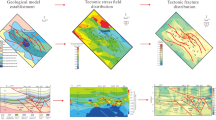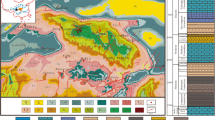Abstract
The Lower Jurassic low porosity and low permeability Ahe Formation is the major reservoir of Dibei Gasfield in the Kuqa Depression, Tarim Basin. Natural fractures are important spaces for storage of hydrocarbons in low permeability reservoirs and can significantly improve the fluid flow capability; therefore, predicting the location and intensity of natural fractures in the Ahe Formation are of extreme importance. In the present study, the Late Himalayan paleotectonic stress field, the period of time when the majority of natural fractures generated in the Dibei Gasfield, was simulated and investigated with a three dimensional finite element (3D FE) model, which serves as a starting point for the prediction. Based on the principle of energy conservation and simulated paleotectonic stress field, the relationship between fracture density and stress parameter was established, and hence, natural fractures in the Ahe Formation of Dibei Gasfield were predicted. The results indicated that the development and distribution of natural fractures were primarily fault-controlled. Regions with well-developed natural fractures were mainly located in fault zones and around faults. Tectonic activities and ultra-high pressures were the dominant factors for natural fractures in the Ahe Formation. Regions with higher development degree of natural fractures in the Ahe Formation usually have a larger gas production; therefore, regions among Well Y1, B3, X1 and B2 should be focused in the Dibei Gasfield.
Similar content being viewed by others
References
Aydin, A., 2000, Fractures, faults, and hydrocarbon entrapment, migration and flow. Marine and Petroleum Geology, 17, 797–814.
Chen, J., Lu, H.F., Wang, S.L., and Shang, Y.J., 2005, Geometric tests and their application to fault-related folds in Kuqa. Journal of Asian Earth Sciences, 25, 473–480.
Cosgrove, J.W., 2001, Hydraulic fracturing during the formation and deformation of a basin: A factor in the dewatering of low-permeability sediments. American Association of Petroleum Geologists Bulletin, 85, 737–748.
Ding, W.L., Li, C., Li, C.Y., Xu, C.C., Jiu, K., Zeng, W.T., and Wu, L.M., 2012, Fracture development in shale and its relationship to gas accumulation. Geoscience Frontiers, 3, 97–105.
Du, X., Zheng, H.Y., and Jiao, X.Q., 1995, Abnormal pressure and hydrocarbon accumulation. Earth Science Frontiers, 2, 137–148. (in Chinese with English abstract)
Feng, J.W., Dai, J.S., Ma, Z.R., Zhang, Y.J., and Wang, Z.K., 2011, The theoretical model between fracture parameters and stress field of low-permeability sandstones. Acta Petrolei Sinica, 32, 664–671. (in Chinese with English abstract)
Fischer, K. and Henk, A., 2013, A workflow for building and calibrating 3-D geomechanical models- a case study for a gas reservoir in the North German Basin. Solid Earth, 4, 347–355.
Florez-Nino, J.M., Aydin, A., Mavko, G., Antonellini, M., and Ayaviri, A., 2005, Fault and fracture systems in a fold and thrust belt: an example from Bolivia. American Association of Petroleum Geologists Bulletin, 89, 471–493.
Gray, D., Roberts, G., and Head, K., 2002, Recent advances in determination of fracture strike and crack density from P-wave seismic data. The Leading Edge, 21, 280–285.
Hanks, C.L., Lorenz, J., Teufel, L., and Krunhardt, A.P., 1997, Lithologic and structural controls on natural fracture distribution and behavior within the Lisburne Group, northeastern Brooks Range and north slope subsurface, Alaska. American Association of Petroleum Geologists Bulletin, 81, 1700–1720.
He, D.F., Zhou, X.Y., Yang, H.J., Lei, G., and Ma, Y.J., 2009, Geological structure and its controls on giant oil and gas fields in Kuqa Depression, Tarim Basin: a clue from new shot seismic data. Geotectonica et Metallogenia, 33, 19–32. (in Chinese with English abstract)
Hennings, P.H., Olson, J.E., and Thompson, L.B., 2000, Combining outcrop data and three-dimensional structural models to characterize fractured reservoirs: an example from Wyoming. American Association of Petroleum Geologists Bulletin, 84, 830–849.
Hou, G.T., Kusky, T.M., Wang, C.C., and Wang, Y.X., 2010, Mechanics of the giant radiating Mackenzie dyke swarm: a paleostress field modeling. Journal of Geophysical Research: Solid Earth, 115, 1–14.
Ji, Z.Z., Dai, J.S., and Wang, B.F., 2010, Quantitative relationship between crustal stress and parameters of tectonic fractures. Acta Petrolei Sinica, 31, 68–72. (in Chinese with English abstract)
Jia, C.Z., Wei, G.Q., Li, B.L., Xiao, A.C., and Ran, Q.G., 2003, Tectonic evolution of two-epoch foreland basins and its control for natural gas accumulation in China’s mid-western areas. Acta Petrolei Sinica, 24, 13–17. (in Chinese with English abstract)
Jia, D., Lu, H.F., Cai, D.S., Wu, S.M., Shi, Y.S., and Chen, C.M., 1998, Structural features of northern Tarim Basin: implications for region tectonics and petroleum traps. American Association of Petroleum Geologists Bulletin, 82, 147–159.
Jiang, Z.X., Li, F., Yang, H.J., Li, Z., Liu, L.F., Chen, L., and Du, Z.M., 2015, Development characteristics of fractures in Jurassic tight reservoir in Dibei area of Kuqa Depression and its reservoir-controlling mode. Acta Petrolei Sinica, 36, 102–111. (in Chinese with English abstract)
Jiu, K., Ding, W.L., Huang, W.H., You, S.G., Zhang, Y.Q., and Zeng, W.T., 2013, Simulation of paleotectonic stress field within Paleogene shale reservoirs and prediction of favorable zones for fracture development within the Zhanhua Depression, Bohai Bay Basin, east China. Journal of Petroleum Science and Engineering, 110, 119–131.
Ju, W., Hou, G.T., Feng, S.B., Zhao, W.T., Zhang, J.Z., You, Y., Zhan, Y., and Yu, X., 2014a, Quantitative prediction of the Yanchang Formation Chang 63 reservoir tectonic fracture in the Qingcheng-Heshui area, Ordos Basin. Earth Science Frontiers, 21, 310–320. (in Chinese with English abstract)
Ju, W., Hou, G.T., and Hari, K.R., 2013a, Mechanics of mafic dyke swarms in the Deccan Large Igneous Province: palaeostress field modeling. Journal of Geodynamics, 66, 79–91.
Ju, W., Hou, G.T., Huang, S.Y., and Ren, K.X., 2013b, Structural fracture distribution and prediction of the Lower Jurassic Ahe Formation sandstone in the Yinan-Tuzi area, Kuqa Depression. Geotectonica et Metallogenia, 37, 592–602. (in Chinese with English abstract)
Ju, W., Hou, G.T., and Zhang, B., 2014b, Insights into the damage zones in fault-bend folds from geomechanical models and field data. Tectonophysics, 610, 182–194.
Ju, W. and Sun, W.F., 2016, Tectonic fractures in the Lower Cretaceous Xiagou Formation of Qingxi Oilfield, Jiuxi Basin, NW China. Part two: Numerical simulation of tectonic stress field and prediction of tectonic fractures. Journal of Petroleum Science and Engineering, 146, 626–636.
Ju, W., Sun, W.F., and Hou, G.T., 2015, Insights into the tectonic fractures in the Yanchang Formation interbedded sandstone-mudstone of the Ordos Basin based on core data and geomechanical models. Acta Geologica Sinica (English Edition), 89, 1986–1997.
Ju, Y., Sun, X.W., Liu, L.W., Xie, Y.N., and Wei, H.X., 2014c, Characteristics of Jurassic tight sandstone gas reservoir in Dibei area of Kuqa Depression, Tarim Basin. Xinjiang Petroleum Geology, 35, 264–267. (in Chinese with English abstract)
Kattenhorn, S.A., Aydin, A., and Pollard, D.D., 2000, Joints at high angles to normal fault strike: an explanation using 3-D numerical models of fault-perturbed stress fields. Journal of Structural Geology, 22, 1–23.
Li, D.P., 1997, The Development of the Low Permeability Sandstone Oil Field. Petroleum Industry Press, Beijing, 354 p. (in Chinese)
Li, Z., Song, W.J., Peng, S.T., Wang, D.X., and Zhang, Z.P., 2004, Mesozoic–Cenozoic tectonic relationships between the Kuqa subbasin and Tian Shan, northwest China: constraints from depositional records. Sedimentary Geology, 172, 223–249.
Lin, T., Yi, S.W., Ye, M.L., Ran, Q.G., Wei, H.X., and Liu, W.H., 2014, Characteristic of tight sandstone gas reservoir and the enrichment regularity in eastern Kuqa Depression. Geological Science and Technology Information, 33, 116–122. (in Chinese with English abstract)
Liu, G.D., Sun, M.L., Lv, Y.F., and Sun, Y.H., 2008, The effectiveness assessment of gas accumulation processes in Kuqa depression, Tarim Basin, Northwest China. Science in China Series D: Earth Sciences, 51, 117–125.
Liu, Y.K., Wu, G.H., Hu, J.F., Wang, J.N., Zheng, D.M., and Wu, J.G., 2004, Analyzing the characteristics of Yinan-2 gas reservoir in Kuche Depression of Talimu Basin. Natural Gas Industry, 24, 12–14. (in Chinese with English abstract)
Lu, H., Lu, X.S., Fan, J.J., Zhao, M.J., Wei, H.X., Zhang, B.S., and Lu, Y.H., 2016, Controlling effect of fractures on gas accumulation and production within the tight sandstone: a case study on the Jurassic Dibei gas reservoir in the eastern part of the Kuqa foreland basin, China. Journal of Natural Gas Geoscience, 1, 61–71.
Lu, H.F., Jia, D., Chen, C.M., Liu, Z.H., and Wang, G.Q., 1999, Nature and timing of the Kuqa Cenozoic structures. Earth Science Frontiers, 6, 215–221. (in Chinese with English abstract)
Manzocchi, T., Childs, C., and Walsh, J.J., 2010, Faults and fault properties in hydrocarbon flow models. Geofluids, 10, 94–113.
McQuillan, H., 1973, Small-scale fracture density in Asmari Formation of southwest Iran and its relation to bed thickness and structural setting. American Association of Petroleum Geologists Bulletin, 57, 2367–2385.
Mueller, M.C., 1992, Using shear waves to predict lateral variability in vertical fracture intensity. The Leading Edge, 11, 29–35.
Sibson, R.H., 2003, Brittle-failure controls on maximum sustainable overpressure in different tectonic regimes. American Association of Petroleum Geologists Bulletin, 87, 901–908.
Smart, K.J., Ferrill, D.A., and Morris, A.P., 2009, Impact of interlayer slip on fracture prediction from geomechanical models of faultrelated folds. American Association of Petroleum Geologists Bulletin, 93, 1447–1458.
Tapponnier, P. and Molnar, P., 1977, Active faulting and tectonics in China. Journal of Geophysical Research, 82, 2905–2930.
Teeuw, D., 1971, Prediction of formation compaction from laboratory compressibility data (SPE paper 2973). Society of Petroleum Engineering Journal, 11, 263–271.
Wang, K., Dai, J.S., Zhang, H.G., Zhang, D.D., and Zhao, L.B., 2014, Numerical simulation of fractured reservoir stress sensitivity: a case study from Kuqa depression Keshen gas field. Acta Petrolei Sinica, 35, 123–133. (in Chinese with English abstract)
Wang, P., 2001, Tectonic Mechanic Principles of Oil-bearing Basins. Petroleum Industry Press, Beijing, 156 p. (in Chinese)
Wei, H.X., Xie, Y.N., Mo, T., Wang, Z.T., Li, L., and Shi, L.L., 2015, Fracture characteristic and its contribution to hydrocarbon accumulation in tight sandstone reservoir in Dibei gas pool in Kuqa Depression, Tarim Basin. Xinjiang Petroleum Geology, 36, 702–707. (in Chinese with English abstract)
Xing, H.S., Li, J., Sun, H.Y., Wang, H., Yang, Q., Shao, L.Y., Yang, D., and Yang, S., 2012, Differences of hydrocarbon reservoir forming between southwestern Tarim basin and Kuche mountain front. Natural Gas Geoscience, 23, 36–45. (in Chinese with English abstract)
Yang, S.G. and Zou, H.Y., 2004, A discussion on the genesis of Jurassic abnormal high pressure in the Yinan structural belt, Kuqa Depression. Henan Petroleum, 18, 20–24. (in Chinese)
Yin, A., Nie, S., Craig, P., Harrison, T.M., Ryerson, F.J., Qian, X.L., and Yang, G., 1998, Late Cenozoic tectonic evolution of the southern Chinese Tian Shan. Tectonics, 17, 1–27.
Zhang, M.L., Tan, C.X., Tang, L.J., Jiang, W., Yang, M.L., and Zeng, L.B., 2004, An analysis of the Mesozoic–Cenozoic tectonic stress field in Kuqa Depression, Tarim Basin. Acta Geoscientica Sinica, 25, 615–619. (in Chinese with English abstract)
Zhang, Z.P., Wang, Q.C., Wang, Y., and Li, T.J., 2006, Brittle structure sequence in the Kuqa Depression and its implications to the tectonic paleostress. Earth Science, 31, 309–316. (in Chinese with English abstract)
Zeng, L.B. and Li, X.Y., 2009, Fractures in sandstone reservoirs with ultra-low permeability: a case study of the Upper Triassic Yanchang Formation in the Ordos Basin, China. American Association of Petroleum Geologists Bulletin, 93, 461–477.
Zeng, L.B., Wang, H.J., Gong, L., and Liu, B.M., 2010, Impacts of the tectonic stress field on natural gas migration and accumulation: a case study of the Kuqa Depression in the Tarim Basin, China. Marine and Petroleum Geology, 27, 1616–1627.
Zhao, W.Z., Zhang, S.C., Wang, F.Y., Cramer, B., Chen, J.P., Sun, Y.G., Zhang, B.M., and Zhao, M.J., 2005, Gas systems in the Kuche Depression of the Tarim Basin: source rock distributions, generation kinetics and gas accumulation history. Organic Geochemistry, 36, 1583–1601.
Author information
Authors and Affiliations
Corresponding author
Rights and permissions
About this article
Cite this article
Ju, W., Wang, K., Hou, G. et al. Prediction of natural fractures in the Lower Jurassic Ahe Formation of the Dibei Gasfield, Kuqa Depression, Tarim Basin, NW China. Geosci J 22, 241–252 (2018). https://doi.org/10.1007/s12303-017-0039-z
Received:
Accepted:
Published:
Issue Date:
DOI: https://doi.org/10.1007/s12303-017-0039-z




